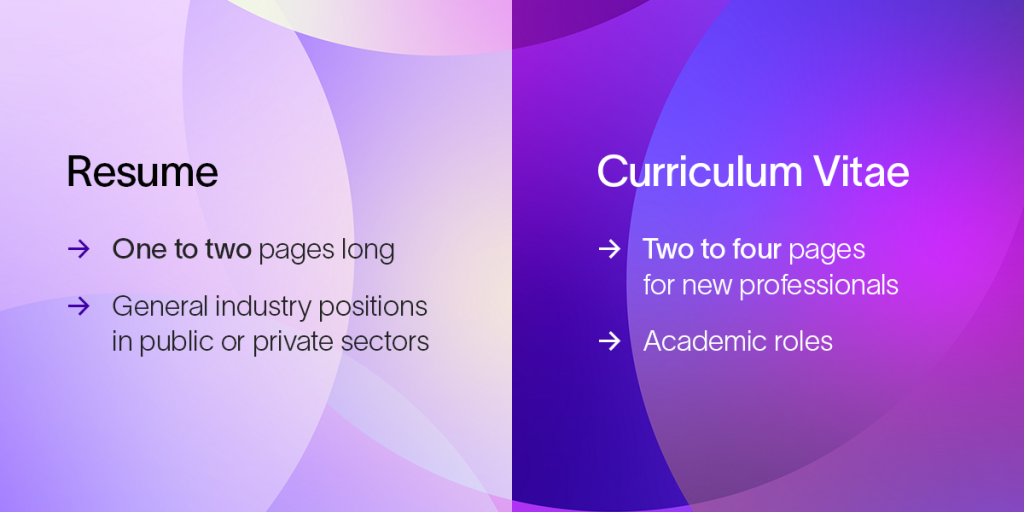
From crafting a compelling cover letter to assembling a stellar resume, several steps go into applying for a job. With all these factors to consider, the application process can seem daunting. However, it’s surprisingly uncomplicated with the right tips and ample preparation.
What makes a good job application? What can applicants do differently in their resumes, cover letters and other aspects of the application process? Learn how to stand out from other applicants with these nine must-know tips.
9 Job Application Tips to Stand Out From Other Candidates
Creating a golden resume doesn’t have to be a hassle — it just takes proper planning. These nine tips for applying for a job will help your application stand out.
1. Include a Cover Letter
While sometimes optional, cover letters can really spruce up an application. A cover letter offers many benefits:
- It helps the employer get to know the candidate better.
- It complements the resume, making it easier for the employer to see how the applicant’s qualifications align with the position.
- It shows more of the candidate’s personality and adds character to their application.
- It further spotlights the skills and experiences the candidate brings to the table.
A resume can accomplish these things on its own, but a cover letter takes it a step further. It gives the employer a better idea of an applicant’s proficiency for the role. The goal is to land an interview, and a cover letter can make a stellar first impression.
Keep these other job application cover letter tips in mind:
- Be concise: A cover letter simply introduces a resume, so superfluousness isn’t necessary. Aim to keep it between 250 and 400 words and roughly three to six paragraphs.
- Customize the letter to the job: Try not to use the same cookie-cutter letter for every application. Employers can easily pick out a rushed cover letter. It’s obvious when a candidate uses a generic template, merely swapping out the job title and business name. To make your cover letter stand out, always tailor it to the company and role.
2. Keep the Resume Concise
When compiling a resume, remember that less could be more. As a standard rule of thumb, a resume should be one to two pages long. Three pages or more can seem unnecessarily wordy and time-consuming. In some cases, the hiring manager or recruiter may skip over it altogether, regardless of the applicant’s suitability for the job. Candidates should be able to summarize their experiences succinctly, even if they have vast expertise in the field.
The ideal length can also vary depending on the role and experience level. For example, a one-page resume will suffice for a recent graduate with under 10 years of experience. A mid-to-late career professional may have a two-page resume, as they may be unable to fit all relevant information into one page. This length provides adequate space to sell their achievements while letting the employer scan the text quickly.

Additionally, note the difference between a resume and a curriculum vitae (CV). A CV’s format resembles a resume. However, it tends to be longer and more comprehensive, typically ranging from two to four pages for new professionals. A maximum CV length of 10 pages is recommended for more seasoned applicants.
Resumes typically work when applying for general industry positions in public or private sectors. CVs function better for academic roles or programs, like teaching and research positions, fellowships and grants.
Note these other tips for keeping a resume readable and professional:
- Avoid “I” and other first-person pronouns.
- Use bullet points to make information scannable.
- Use sans serif fonts since they’re easier to read on a screen.
- Keep body font size between 10 and 12 — headings can be slightly bigger, but ideally no larger than 14.
- Avoid adding photographs. They distract from the resume’s content, interfere with the applicant tracking system (ATS) and take up valuable space.
3. Emphasize Unique Traits
No two applicants have the exact same backgrounds, skills, experiences and achievements. Applicants should consider what makes them stand out and stress these characteristics in their application. Not sure what makes you stand out from other applicants? Ask the following questions:
- What are my most notable skills, accomplishments and personality traits?
- How can I use these traits to contribute to the organization in a productive way?
- How have I used these attributes to encourage positive change at my previous workplaces?
Candidates should think about their most remarkable traits and experiences and how these capabilities suit them for the role. They should also ponder examples from their past work experiences to support these features. They may be asked about these attributes during an interview.
4. Back Up Work Experience With Hard Data
By including numbers and figures on their resume, an applicant can boost their likelihood of landing an interview by up to 40%. Employers want tangible evidence of how a candidate can drive positive results for the company. There’s no more foolproof way to accomplish this than with quantitative facts and data.
An applicant might include details like these in their resume:
- Spearheaded a project that resulted in the company saving $X
- Helped increase sales by $X over the course of X years
- Increased efficiency by X% by leading a team of X people in weekly meetings and daily tasks
Numbers and statistics help draw an employer’s eye to a resume. They help support and endorse a candidate’s measurable impact on a business. An applicant can talk about their accomplishments on their resume all day long, but concrete numerical data actually substantiates these claims.
5. Leverage the Job Description
When crafting the perfect resume and cover letter, a job description can be powerful food for thought. Job seekers can use this description to their advantage when filling out their application. Why? Because it shows employers precisely what they’re looking for.
A job description provides a basic rundown of the role. It includes the title, basic responsibilities, and required education and experience. In fact, a candidate will likely only be considered for the position if they meet these parameters. Therefore, they can benefit from tailoring their application to this description.
Like the employer has persuaded applicants with this description, prospective candidates need to persuade employers with their application. Candidates should come by honestly in their resumes — not just copy down the description word-for-word. They should analyze the description carefully and determine pertinent experiences that meet these requirements.
Compare and contrast the resume against the job description. How do they resemble each other? What areas could be improved? If the description requests a specific skill not currently on the resume, an applicant should include it if they can do so honestly. The job description is there for reference, so applicants should make the best use of it.
6. Research the Company Extensively

One of the most crucial job application measures involves researching the company thoroughly. By learning as much as possible about the corporation, an applicant shows they took the time to understand its goals and mission.
Detailed research displays a genuine interest in the business, its accomplishments and its objectives. It also helps applicants find common ground with the organization. When researching a company, applicants can:
- Browse its website to understand its products, services, brand voice, culture, values and mission.
- Speak with current employees for a more accurate idea of how the company operates.
- Research its competitors for a better understanding of the market and industry.
- Read blog posts and news articles to stay on top of breaking company developments and other relevant industry news.
A job searcher should always do their homework on the company and role they’re applying for. In fact, research should be the first step of the application process. It helps candidates gauge what the company looks for in new hires, and they can tailor their application based on their findings.
They can uncover key pieces of information to leverage in their cover letter, resume and interview. In turn, they can appear more knowledgeable during the interview stage, giving them the upper hand over less-prepared applicants.
7. Triple-Check Spelling and Grammar
A resume with proper spelling and grammar conveys several positive traits — including attention to detail, communication, precision and professionalism — all of which employers value in a candidate.
An application riddled with typos, grammatical errors and formatting mistakes can raise questions about a candidate’s communication skills and proficiency for the role — even if they have a laundry list of skills and experiences. In fact, 77% of employers immediately remove resumes from consideration due to bad grammar and typos.
Spelling and grammar flaws do more than disrupt the overall content and message. They also reduce an applicant’s chance of passing an applicant tracking system (ATS). An ATS scans resumes for relevant criteria and keywords. It filters out applications that don’t match these qualifications. Typos and other mistakes can decrease a candidate’s score or even lead to rejection by the ATS.
Additionally, glaring spelling and grammar flaws can cause misunderstandings of an applicant’s qualifications. Even a minor mistake can completely flip the intended meaning of a sentence, causing needless confusion. Candidates should always check their applications carefully for correct spelling and grammar.
When an applicant meticulously proofreads their resume, they present themselves as a reliable communicator and competent candidate. It’s also wise to have others proofread these documents. The more pairs of eyes review it, the more likely an overlooked typo or grammatical error will be spotted.
Employers value strong communication skills, no matter the industry. A well-written resume indicates the ability to communicate ideas clearly, accurately and concisely, increasing an applicant’s chances of landing an interview.
8. Show a Willingness to Grow and Learn
Employers value teachable workers with a desire to learn new skills and grow in their careers. When a candidate displays their passion for learning, they demonstrate perseverance and the ability to overcome challenges. Even if they have minimal industry experience, simply conveying their enthusiasm to learn could win an employer over and secure an interview.

Applicants should provide specific examples of achievements that communicate an interest in learning. For instance, they might ask themselves these questions when filling out an application:
- What resources and tools did I use to help me develop both professionally and personally?
- How did I apply these resources to achieve my professional and personal goals?
Candidates can showcase this desire to learn and grow through multiple mediums, including their cover letter, resume and interview.
9. Choose Resume Formatting Strategically
Resume formatting style is another core consideration when applying for a job. Applicants can choose between one of these three standard resume formats:
- Chronological: A chronological resume lists a candidate’s work experiences in reverse order. It starts with their most recent position and goes backward from there. Chronological is the most common resume format.
- Functional or skills-based: A functional resume highlights strengths and skills valuable to employers. Rather than a “work history” section with a chronological timeline, it usually includes an accomplishments section listing the professional skills a candidate has developed over the years. Typically, it forgoes specific names, places and dates. It often includes a headline or summary at the top, which outlines the individual’s primary achievements and skills. It might have a brief work history list at the bottom or omit information about the person’s employment history altogether.
- Combination: A combination or hybrid resume blends features of chronological and functional resumes. It equally emphasizes professional skills and work history.
How does one determine the best way to format their resume? There’s no hard-and-fast rule when it comes to resume formatting, but a few general tips and guidelines can help.
Employers tend to prefer chronological resumes, as they can easily see a candidate’s jobs and when they held these positions. They’re straightforward and simple to follow. They also integrate the type of data ATS systems screen for. As a result, these systems can more accurately select candidates based on job-related keywords.
Skills-based resumes suit those who:
- Have gaps in their employment history.
- Plan to switch careers.
- Are new to the workforce or have limited experience.
Combination resumes work best for seasoned professionals with abundant work experience. These individuals may also have gaps in their employment history. People looking to change careers or land a niche position can benefit from including both skills and experiences. However, combination resumes may not make sense for recent graduates, current students and people with clear, consistent progression paths in their industry.
Keep in mind that combination can be the most difficult format. Applicants should stick with chronological or functional unless they have a valid reason to use a combination resume.
Find Other Tips for Workforce Success With Danaher
Whether you’re a recent graduate, looking to change career paths or entering a new industry, Danaher can help make the transition easier. By browsing our blog or joining our Talent Community, you’ll receive valuable pointers for establishing new career paths and discovering your true potential.
You can also view our available job openings in IT, health and safety, business development, marketing, and an array of other industries. Take the next steps in achieving your long-term career goals with Danaher!


Leave a Reply